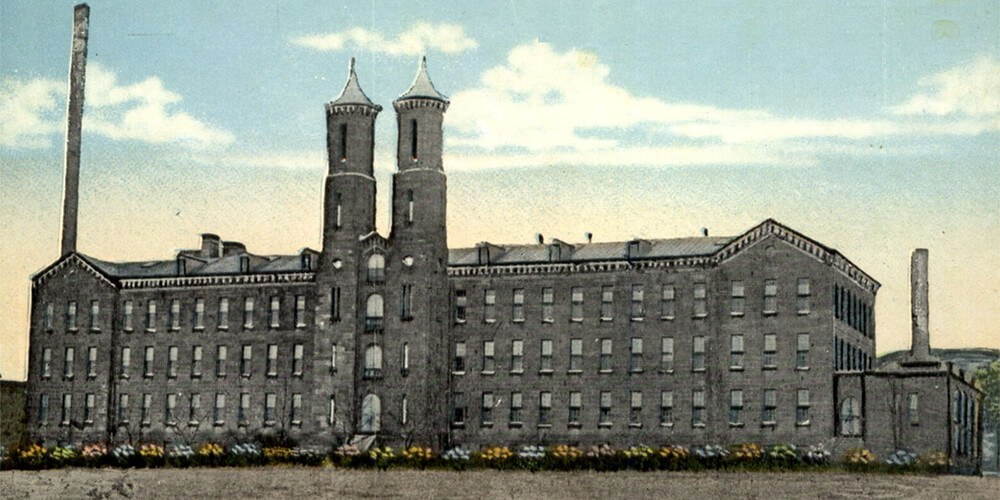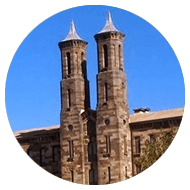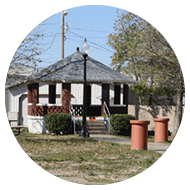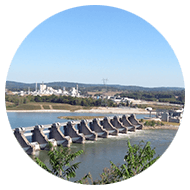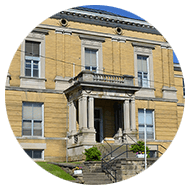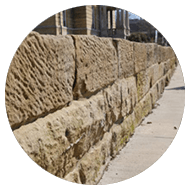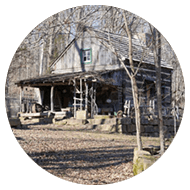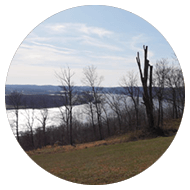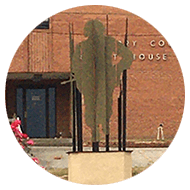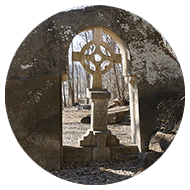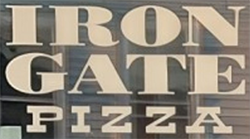Plan Your Visit to Downtown Cannelton, Indiana
There is a very high quantity and quality of historic structures in the downtown Cannelton Historic District. Downtown Cannelton retains much of the charm and character of historic river towns along the Ohio River. This character remains evident in the park space along the river and the historic commercial storefronts along Washington Street. During the heyday of the late-1800’s and early-1900’s, Washington Street functioned as Cannelton’s ‘Main Street’.
Many of the commercial storefronts on Washington Street are built to the property line and are masonry construction with cast iron storefronts. Many of these retain their historic integrity and several have historic awnings over the sidewalks. This historic storefront integrity is largely intact north of 5th Street.
Two historic structures in Cannelton are visually prominent; these include the Cannelton Cotton Mill building with its twin spires and St. Michael’s Catholic Church.
Both of these sandstone structures were constructed in the early-1800 and are on the National Register of Historic Places.
Your Support is Needed to Chart a New Course for our Historic Downtown
Many of the structures in the historic district are in serious structural jeopardy and more than two dozen buildings are vacant. While some residents see little hope for these buildings, others see the historic buildings, albeit deteriorated, as Cannelton’s strongest asset. Renew Cannelton, Inc. is working with civic leaders, business leaders and residents to bring awareness and attention to the needs of our historic downtown.
Historic Cannelton Destinations

Indiana Cotton Mill
Construction of the Cannelton Cotton Mill began in 1849 and was completed in 1851. Designed by Rhode Island architect Thomas Alexander Tefft and built of locally quarried sandstone, the mill was once the largest industrial building in the United States west of the Allegheny Mountains. The mill remains the largest and most historically significant structure in Cannelton. The mill is located on the north side of Washington Street between 3rd and 4th Streets.
The driving force behind the mill's construction was Hamilton Smith, a prominent attorney from Louisville, Kentucky. Smith's vision was to create a western milling center to rival Lowell, Massachusetts, but using steam-powered machinery fired by locally produced coal instead of the hydropower that ran the Lowell mills.
It operated as a cotton mill for over 100 years until closing in 1954. It was listed on the National Register of Historic Places in 1975 and became a National Historic Landmark in 1991. The adaptive restoration of the mill to a 70-unit, low-income apartment complex was completed in 2003.
St. Michael Catholic Church
The cornerstone of St. Michael Catholic Church was laid in 1858. It features a 156-foot high spire and a bell tower containing four bells. It also has a large clock that chimes every half hour. From the ornate arch over the doorway to the subtle etchings that embellish each block, the stonework of St. Michael Church is stunningly beautiful. Built by old world masters, the church stands as an exemplar of early Indiana stonework.
The church was built for German and French families in the area. St. Michael Catholic Church is listed in the National Register of Historic Places.
Cannelton River Trail
Recently the City of Cannelton, in partnership with the Perry County Greenway and The Cannelton Foundation, Inc., opened the Cannelton River Trail. This trail connects with the Hargis Hafele Riverfront Park and runs along the river side of the floodwall toward our neighbor Tell City. As grants become available the city welcomes any partnerships in continuing to add to the length of the Cannelton River Trail and connecting to our neighbors and strengthen the Perry County Greenways.
Hoosier National Forest
Hoosier National Forest is Indiana’s premier forest land and is open year-round for public enjoyment. The forest spans nine different counties. 60,000 acres of the Hoosier National Forest lay in Perry County.

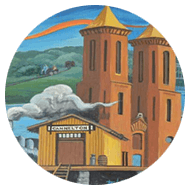
Hargis Hafele Riverfront Park
Hargis Hafele Riverfront Park is located on the Ohio River with the entryway located at the end of Taylor Street. This park includes a boat ramp used by boaters from Perry County, Indiana as well as Hancock County, Kentucky which sits directly across the river and is connected by the Bob Cummings Lincoln Trail Bridge. The park is also visited by school outings and other clubs. There is a mural depicting the history of Cannelton buildings painted on the floodwall next to the park.
Gazebo City Park
The city Gazebo Park is located in the center of the city. This park was created when the gazebo needed to be moved because of the city’s new firehouse. This property was donated by the Perry County Recreation Committee to the city. The park is located in the downtown area.
Cannelton Legion Field
The Cannelton Legion Field is owned by the city schools. They host games and tournaments as it is one of the better ball fields in the area. There is also a children’s playground located in the park and some summer programs occur in the park.
Ohio River Recreation & Water Sports
Outdoor enthusiasts will find ample opportunities to enjoy camping, fishing and especially boating and watersports. Construction of the nearby Cannelton Locks and Dam has created a 114 mile-long “lake” from Cannelton to Louisville, Kentucky. This stretch of calm recreational water is ideal for boaters, water skiers and swimmers.
Eagle’s Bluff Park and Overlook
The City of Cannelton annexed the Eagle’s Bluff Park and Overlook into the city limits and it is utilized for family outings, picnics and views of the Ohio River and the Cannelton Locks and Dam. There is also an information building for visitors to the overlook.
Eagle's Bluff Park is Perry County's largest public park/facility, consisting of 128 acres. Originally known as "The Overlook," this facility was created during the construction of the Cannelton Locks and Dam as a means of observing the construction process. The road through the park also served as the detour for State Road 66 during the construction of the dam.
Acquired from the United States Fish and Wildlife Service in 2000, this facility was renovated and reopened to the public in 2008. Situated on a bluff 200 feet above the Ohio River in Cannelton.

Perry County (Courthouse) Museum
The Perry County Museum is located in the building that previously served as the Perry County Courthouse. The former courthouse is in the French Renaissance style, yellow brick with Bedford limestone lintels and massive sandstone foundation which was quarried from the hills near Cannelton. It was built in 1896 and served as the county seat until 1994.
Click here to visit the Museum website
Indiana Sandstone
The bluffs overlooking the Ohio River throughout southern Perry County are abound with sandstone. In 1836, Seth Hunt opened a business on the hillside above Cannelton to mine coal and sandstone. It was his quarry that was used to mine sandstone to build the Cannelton Cotton Mill in 1849.
In a publication in 1850 it was stated that "The sandstones of the hills are an excellent quality of building stone, composed of a great variety of brown, grey, and reddish brown sandstones, mostly free from mica, except some of the grey beds which contain it in very fine particles. The layers are easily quarried, and there are some magnificent quarries in the Cannelton hill, that have been opened to obtain the stone for the erection of the Cannelton Cotton Mill."
Workers harvested large slabs of sandstone by boring holes into the stone and driving wet hickory pegs into them. The pegs expanded overnight and sheared off the slabs of stone that the stonecutters then shaped with chisels and mallets. At first, the sandstone taken from the quarry is soft and easy to work, but after exposure to the air, it hardens and becomes more durable and resilient.
Cannelton is a community that has many historic structures and homes built with native sandstone. It is one of the most significant historical aspects of the city. It is in the foundations of the older structures and the sandstone walls along Highway 66. Sandstone is a very important part of our past, and also our future.

Shubael Little Pioneer Village
The Shubael Little Pioneer Village includes hewn-log vintage homesteads, a blacksmith shop, a carpenter’s shop, The Troy Stone Jail, The Rogier ‘Beehive’ Oven, a mercantile, a smokehouse, a rustic shelter, and The Milestone One-Room School. The setting is reminiscent of the 1850’s, augmented with numerous authentic artifacts.
The village is named after Shubael C. Little, a pioneer and first land owner of the land comprising the village. Shubael settled here in 1837. He helped found the first school at Rome, IN, and a Masonic Lodge in Cannelton. He was a Union Patriot, losing one of his two sons in the Civil War. Shubael’s first wife was buried at the village.
A visit to the Shubael Little Pioneer Village is a rewarding experience for those who enjoy visiting historic sites to reconnect with their ancestors and family history. The Little Pioneer Village is located a short distance from downtown Cannelton.
Click here to visit the Shubael Little Pioneer Village Website

Blue Heron Vineyards & Winery
Blue Heron Vineyards & Winery is located on a bluff overlooking the Ohio River in Perry County. From the lookout plateau at Blue Heron you can enjoy beautiful views of the river and surrounding area while enjoying a variety of wines. Blue Heron Vineyard and Winery is a short distance from downtown Cannelton.
Click here to visit the Blue Heron Vineyards & Winery Website

Perry County Veteran's Park
A local sculptor based in Cannelton, Greg Harris designed and built a piece of sculpture titled “Together We Serve”. The Cannelton Foundation, Inc. purchased the sculpture and donated it to the Perry County Museum to be installed on the museum property henceforth known as the Perry County Veterans Park. The sculpture stands as recognition that those who serve don’t serve alone. There is a family also making sacrifices so that they can serve.

Celtic Cross of Blue Heron
Nestled in the hills of Rocky Point, this Celtic Cross is one of the most amazing pieces of art you’ll ever see. It was conceived by Gary and Lynn Dauby, owners of Blue Heron Vineyards and Winery, and carved by Greg Harris, a local sculptor based in Cannelton. The cross was sculpted within a single 22′ tall stone that is natural to the hillside. It is believed to be the largest known “in-situ” (of its own stone) Celtic Cross in the world. Blue Heron Vineyards and Winery is located just a short distance from downtown Cannelton.



